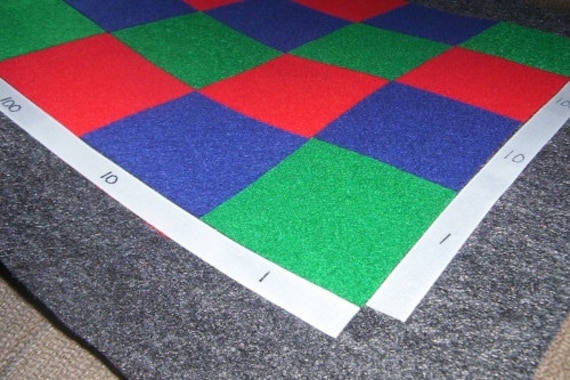Montessori Elementary Mathematics: Multiplication Checkerboard
Materials: white number tiles 0-9, gray numbers
tiles 0-9, checkerboard[1],
checkerboard bead bar box (only has bead bars 1-9)
Introduction:
This
is the checkerboard. We are going to learn how to do multiplication on the
checkerboard.
·
Numbers: We have these numbers across the bottom
(read and point to each number).
·
Multiplicand and Multiplier: This ridge is where we place our
multiplicand and multiplier (indicate
the ridge at the bottom and to the right, respectively). We also have some numbers along the
right side (read and point to
each one). We will put the multiplier here.
·
Squares – color and value: Then we have all of these colored
squares. Here are the units (point
to the lower left corner – green). Tens are here and here (point to each of the blue squares touching the unit square – 2). All of these are hundreds (indicate the diagonal 3 reds). Here we have thousands (indicate these 4). Here are the ten-thousands (indicate these 4). Continue with each category.
·
Squares – value of beads: What is interesting about the
checkerboard is that the value of the bead bar is determined by which square
upon which it is placed. I have a 3-bar; if I put it here (place on the units square), it is three units. If I put it here
(place on a hundred square), it is three hundred; if I put it
here (another hundred), it is still 300. What if I put it
here (place on a 100,000 square). We don’t have to stick with one bead
bar. If I have a 3-bar here (on
tens) and a 5-bar here (on hundreds), we have 530. What if I put it here?
(slide each over one to show 5,300). What if I put it here (slide up and right one place –
diagonally)? It is still
5,300. Repeat until the concept is clear and
the children can readily read the numbers on the board – invite them to place
beads and you read the number; and to place beads to read the numbers
themselves.
Exercise
1: representing each multiplication with the bead bars
Prerequisites:
knowledge of the process of
multiplication; Introduction to the checker-board; Ability to read hierarchical
numbers; (technically the children can do the 1st exercise without
knowing the multiplication facts); Can precede work on the large bead frame
(this exercise only)
Notes: If the children choose very large digits, they will have a
ton of bead bars in each square that will overflow into other squares. In that
situation, after they have done the multiplications, exchange within each row
before sliding diagonally; then finish the exchanging to reach the final
answer.
This
work can help the children learn their multiplication because they are
represented by the quantities they are putting down each time. If they do know
their facts and they’ve caught on to the procedure of exercise 1, move them
right on to exercise 2 on another day.
Exercise
2: Using the Multiplication Facts
Purpose:
Further experience in long
multiplication. Indirect preparation for category multiplication.
[1] Boards: current manufacturing
only go to units of millions; felt version and the presentation in AMI training
goes to hundred-millions on the horizontal
why does the checkerboard have more than 3 spaces per grouping? e.g. multiples of thousands beyond hundred thousand?
Not to be confused with the Decimal Checkerboard (some tidbits found at Montessori Trails - a Montessori Nugget will be posted soon).

